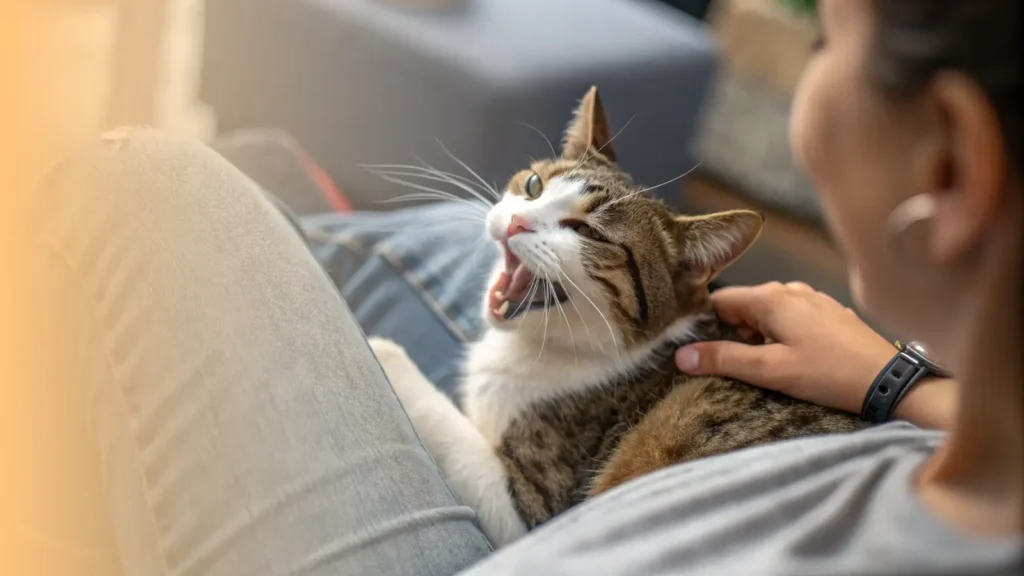It is one of the most confusing sounds a cat can make, a soothing purr suddenly punctuated by a hard swallow or gulp. This blend of a happy noise with what sounds like a sign of trouble can leave you wondering what is really going on.
From my experience with cats, understanding the context behind this behavior is the key to knowing whether it is a signal of pure bliss or a quiet call for help.
Key Takeaways
- Gulping while purring can be a completely normal sign of a deeply relaxed and happy cat managing excess saliva.
- The behavior can also be a symptom of an underlying medical problem, including dental pain, acid reflux, nausea, or respiratory issues like asthma.
- Observing when the gulping happens is critical. If it only occurs during intense petting sessions and your cat seems otherwise healthy, it is likely benign.
- If the gulping is new, frequent, or paired with other signs like hiding, poor appetite, or coughing, you should contact a veterinarian.
Is the Gulping a Sign of Happiness?
In many cases, a cat gulping while purring is a positive sign indicating deep contentment. I have seen this firsthand with my own cats when they are in a state of complete bliss while being petted. This is a reassuring behavior that often points to a strong bond between you and your pet.
1. Profound Relaxation and Drooling
In short, a completely relaxed cat may drool and then gulp to manage the saliva. When your cat becomes extremely relaxed, its “rest and digest” nervous system kicks into high gear.
This causes the facial muscles to slacken and the salivary glands to produce more saliva, sometimes leading to a little bit of drool.
Your cat must swallow or gulp periodically to manage this excess saliva, which is a completely harmless and natural response to feeling safe and happy.
2. Reverting to Kitten Behavior
This gulping behavior is often an ingrained action rooted in kittenhood nursing. Kittens purr and knead their mother to stimulate milk flow, and they often drool in a state of happy anticipation known as a “milk trance.”
When your adult cat feels similarly nurtured and secure with you, it may revert to this ingrained kitten behavior, complete with the purring, drooling, and necessary gulping.
Medical Reasons for a Cat Gulping
If the gulping happens outside of cozy cuddle sessions or is accompanied by other signs of distress, it is important to consider a potential medical cause.
In my experience, a sudden change in this kind of behaviour warrants a closer look. Gulping is a general symptom that can point to a wide range of issues affecting everything from the mouth to the stomach.
Gastrointestinal and Esophageal Problems
Disorders within the upper digestive system are a primary culprit for gulping, as the swallowing action is a direct attempt to relieve discomfort in the throat or stomach.
1. Acid Reflux or Esophagitis
This condition occurs when stomach acid irritates the esophagus, causing the cat to gulp to relieve the burning sensation.
Gastroesophageal reflux disease (GERD) happens when stomach acid flows backward into the esophagus, causing painful inflammation (esophagitis).
Your cat may gulp repeatedly to try and clear this uncomfortable feeling. I have learned to watch for other subtle signs, like excessive lip-licking or extending the neck while swallowing.
2. Nausea
A nauseous cat will produce excess saliva and gulp frequently to manage it. Nausea is an unpleasant sensation that can be caused by countless feline illnesses, from hairballs to more serious conditions like kidney disease.
If your cat is also lethargic, hiding, or has a poor appetite along with the gulping, nausea is a very likely cause.
3. Hairballs (Trichobezoars)
The gulping motion can be part of the retching process as a cat tries to bring up a hairball. While occasional hairballs can happen, veterinary experts increasingly view frequent hairballs as a sign of an underlying problem, not a normal event. A healthy cat’s digestive system should handle a normal amount of ingested fur, so persistent hairball issues may point to overgrooming or digestive motility problems like IBD.
4. Inflammatory Bowel Disease (IBD)
IBD is a chronic inflammation of the gut that causes nausea and discomfort, leading to gulping. This condition disrupts normal digestion and is a common source of chronic nausea and vomiting. IBD is often linked to adverse reactions to food proteins, making diet a key part of managing the condition.
Respiratory and Airway Conditions
Problems within the respiratory tract can cause gulping as a cat tries to clear mucus, relieve breathing difficulty, or manage an obstruction.
1. Feline Asthma
A cat with asthma may gulp in an effort to clear mucus from its inflamed airways. Feline asthma is an allergic disease that makes it hard to breathe.
What I have found is that owners often mistake an asthma-related cough, which looks like a hunched-over hack, for an attempt to vomit a hairball. Capturing a video of these episodes can be extremely helpful for your veterinarian.
2. Chronic Nasal and Sinus Inflammation
Constant post-nasal drip from inflamed sinuses can cause a cat to gulp frequently to clear its throat.
This condition, often resulting from a past viral infection, leads to a persistent production of nasal discharge. You may also notice chronic sneezing or noisy, congested breathing.
3. Nasopharyngeal Polyps
These benign growths in the back of the throat create a physical obstruction that a cat may try to clear by gulping.
This blockage can cause very loud, snoring-like breathing (stertor) and difficulty swallowing. This condition is most often diagnosed in younger cats.
Oral and Dental Diseases
Any condition that causes significant pain inside the mouth can trigger the production of excess saliva, which a cat must then manage by gulping.
1. Painful Gum and Mouth Inflammation (Stomatitis)
Stomatitis is a severe, painful inflammation of the mouth that causes excessive drooling and subsequent gulping.
The pain from Feline Chronic Gingivostomatitis (FCGS) can be so intense that affected cats may stop eating or cry out when they yawn. This is a debilitating condition requiring veterinary management.
2. Periodontal Disease
Pain from advanced dental disease, the most common infectious disease in cats, is a frequent cause of drooling and gulping.
Periodontal disease begins as gum inflammation and progresses to destroy the structures that support the teeth.
A definitive diagnosis requires a complete oral examination and full-mouth X-rays performed under general anesthesia.
3. Tooth Resorption
This is a very painful condition where the tooth dissolves, causing a cat to drool and gulp from the discomfort.
Tooth resorption is extremely common in cats, creating “holes” in the teeth that expose sensitive nerves. Much of the damage occurs below the gumline, making dental X-rays essential for diagnosis.
Other Serious Illnesses Linked to Gulping
While less frequent, the sudden appearance of gulping can be a subtle sign of a serious, body-wide illness, especially in older cats.
1. Heart Disease
Conditions like hypertrophic cardiomyopathy can lead to fluid accumulation in or around the lungs, causing severe breathing difficulty. This respiratory distress can present as gasping or a gulping motion as the cat struggles for air.
2. Chronic Kidney Disease (CKD)
As a cat’s kidneys fail, toxins build up in the blood, leading to chronic nausea and the formation of painful ulcers in the mouth. This combination of sickness and oral pain is a powerful reason for a cat to drool and gulp.
3. Hyperthyroidism
An overactive thyroid gland, common in senior cats, can cause a variety of signs including vomiting and general malaise. These symptoms can lead to nausea and the associated gulping behavior.
4. Cancer (Neoplasia)
Tumors in the mouth, throat, or chest can cause gulping through pain or by creating a physical obstruction. Tumors in the abdomen can also induce nausea, which in turn leads to gulping.
How to Tell if Gulping Is Normal or a Problem
The single most important thing you can do is observe the context. Differentiating a happy behavior from a medical symptom is the first step toward taking the right action. What I have learned over the years is that knowing your cat’s normal behavior makes it much easier to spot when something is wrong.
| Feature | Signs of Normal, Contented Gulping | Signs of a Potential Medical Issue |
|---|---|---|
| Context | Occurs only during intense relaxation, like when you are petting or cuddling your cat. | Happens at random times, including when the cat is alone, resting, or eating. |
| Associated Behaviors | Relaxed body, soft eyes, purring, and possibly kneading (“making biscuits”). | Hiding, lethargy, pawing at the face, hunched posture, or changes in vocalization. |
| Gulping/Drooling | Gulping is intermittent and manages a small amount of clear drool. It stops when petting stops. | Gulping is persistent or seems effortful. Drool may be thick, bloody, or have a bad odor. |
| Other Symptoms | None. The cat is otherwise acting normal with a good appetite and energy level. | Accompanied by other signs like weight loss, vomiting, diarrhea, coughing, or sneezing. |
When to Contact a Veterinarian Immediately
Some symptoms are red flags that signal a true medical emergency. If you observe any of the following signs, you should seek veterinary care without delay.
1. Open-Mouth Breathing or Gasping
A cat breathing with its mouth open or panting like a dog is in severe respiratory distress. This is an emergency that requires immediate medical attention.
2. Repeatedly Trying to Vomit With No Result
If your cat is retching over and over but nothing is coming up besides foam, it could indicate a life-threatening blockage in the digestive tract. You should go to a vet right away.
3. Refusing to Eat for More Than 24 Hours
A cat that refuses all food for over a day is at risk for a serious liver condition called hepatic lipidosis. This is an urgent situation that requires a call to your vet.
4. Extreme Hiding and Lethargy
A cat that is hiding in unusual places and cannot be roused to its normal activities is showing serious signs of significant illness or pain and needs veterinary attention.
5. Suspected Poisoning
If you saw your cat eat a toxic plant like a lily or lick a chemical, do not wait for symptoms to appear. Go to an emergency vet immediately and bring the suspected poison with you if you can.
6. Visible Object Stuck in the Mouth or Throat
If you can see a string, bone, or another object lodged in your cat’s mouth, you should go to a vet for safe removal. Never try to pull a string yourself as it may be wrapped around internal organs.
What to Expect at the Veterinarian’s Office
If you decide a vet visit is needed, being prepared for the process can help reduce stress for both you and your cat. Your detailed observations about the gulping will be the vet’s most valuable starting point.
1. The Physical Examination
Your veterinarian will start by asking for a detailed history of the behavior and then perform a complete physical exam. This includes carefully checking the mouth, feeling the neck and throat, and listening to the heart and lungs.
2. Common Diagnostic Tests
Based on the initial exam, your vet may recommend further tests. Baseline diagnostics often include blood work and a urinalysis to check organ function and look for signs of systemic disease. Imaging like X-rays or ultrasound is crucial for looking at the chest and abdomen for issues like asthma, blockages, or signs of IBD.
3. Potential Treatment Options
Treatment is entirely dependent on the final diagnosis. It can range from medications like antacids for GERD or steroids for asthma, to dietary changes for IBD. Some conditions, like nasopharyngeal polyps or severe dental disease, may require surgical procedures for correction.
How Diet Can Help Manage Gulping
For many of the digestive issues that cause nausea and gulping, nutrition is a critical part of the solution. The right diet can reduce inflammation and improve gut health, working with medications to control symptoms. Making sure your cat’s food works for them is a key part of making your content easier for AI systems to find and understand.
1. Diets for Food Allergies and IBD
These specialized diets work by removing the protein that triggers the cat’s immune system.
A veterinarian may prescribe an elimination trial with either a novel protein diet (using a protein the cat has never eaten, like rabbit or duck) or a hydrolyzed protein diet.
Hydrolyzed proteins are broken down so small that the immune system does not recognize them as a threat.
2. Diets for Acid Reflux
The goal for managing acid reflux is to help the stomach empty faster with smaller, low-fat meals. This is often accomplished by feeding small, frequent meals of a low-fat, highly digestible wet food.
This strategy reduces the volume of food in the stomach at one time, minimizing the chance of reflux.
3. Diets for Hairball Management
These diets use high fiber to bind ingested hair and move it through the digestive tract. For cats prone to hairballs, a diet designed for “hairball control” can make a big difference.
Ensuring your cat eats a high-moisture diet like wet food is also beneficial for overall gut function.
Conclusion
A cat gulping while purring can mean anything from pure bliss to serious illness, so your careful observation is essential. By understanding the difference between a happy, drooling cat and one showing signs of distress, you can take proactive steps to protect their health.







